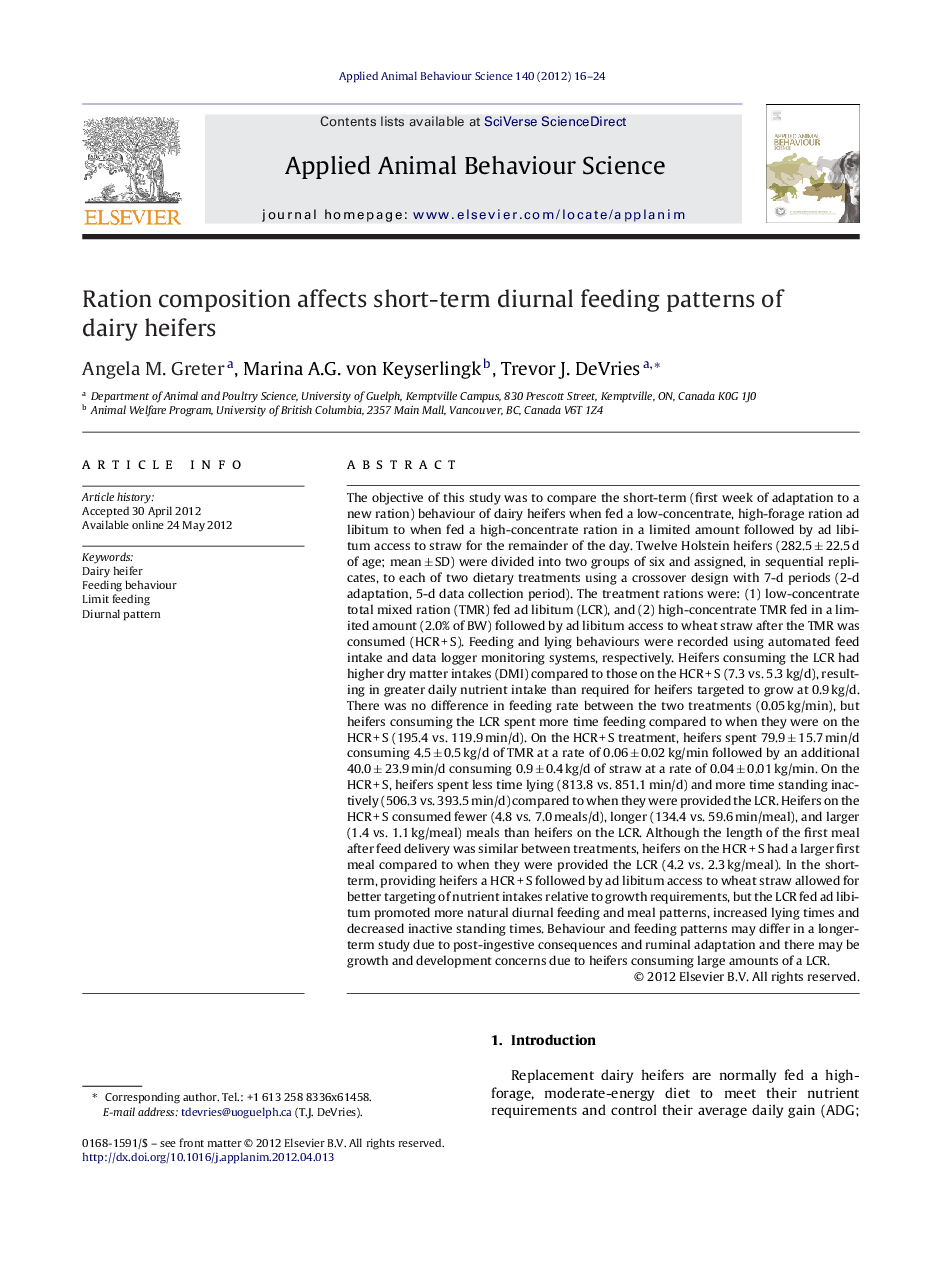| کد مقاله | کد نشریه | سال انتشار | مقاله انگلیسی | نسخه تمام متن |
|---|---|---|---|---|
| 4522909 | 1625373 | 2012 | 9 صفحه PDF | دانلود رایگان |

The objective of this study was to compare the short-term (first week of adaptation to a new ration) behaviour of dairy heifers when fed a low-concentrate, high-forage ration ad libitum to when fed a high-concentrate ration in a limited amount followed by ad libitum access to straw for the remainder of the day. Twelve Holstein heifers (282.5 ± 22.5 d of age; mean ± SD) were divided into two groups of six and assigned, in sequential replicates, to each of two dietary treatments using a crossover design with 7-d periods (2-d adaptation, 5-d data collection period). The treatment rations were: (1) low-concentrate total mixed ration (TMR) fed ad libitum (LCR), and (2) high-concentrate TMR fed in a limited amount (2.0% of BW) followed by ad libitum access to wheat straw after the TMR was consumed (HCR + S). Feeding and lying behaviours were recorded using automated feed intake and data logger monitoring systems, respectively. Heifers consuming the LCR had higher dry matter intakes (DMI) compared to those on the HCR + S (7.3 vs. 5.3 kg/d), resulting in greater daily nutrient intake than required for heifers targeted to grow at 0.9 kg/d. There was no difference in feeding rate between the two treatments (0.05 kg/min), but heifers consuming the LCR spent more time feeding compared to when they were on the HCR + S (195.4 vs. 119.9 min/d). On the HCR + S treatment, heifers spent 79.9 ± 15.7 min/d consuming 4.5 ± 0.5 kg/d of TMR at a rate of 0.06 ± 0.02 kg/min followed by an additional 40.0 ± 23.9 min/d consuming 0.9 ± 0.4 kg/d of straw at a rate of 0.04 ± 0.01 kg/min. On the HCR + S, heifers spent less time lying (813.8 vs. 851.1 min/d) and more time standing inactively (506.3 vs. 393.5 min/d) compared to when they were provided the LCR. Heifers on the HCR + S consumed fewer (4.8 vs. 7.0 meals/d), longer (134.4 vs. 59.6 min/meal), and larger (1.4 vs. 1.1 kg/meal) meals than heifers on the LCR. Although the length of the first meal after feed delivery was similar between treatments, heifers on the HCR + S had a larger first meal compared to when they were provided the LCR (4.2 vs. 2.3 kg/meal). In the short-term, providing heifers a HCR + S followed by ad libitum access to wheat straw allowed for better targeting of nutrient intakes relative to growth requirements, but the LCR fed ad libitum promoted more natural diurnal feeding and meal patterns, increased lying times and decreased inactive standing times. Behaviour and feeding patterns may differ in a longer-term study due to post-ingestive consequences and ruminal adaptation and there may be growth and development concerns due to heifers consuming large amounts of a LCR.
Journal: Applied Animal Behaviour Science - Volume 140, Issues 1–2, August 2012, Pages 16–24